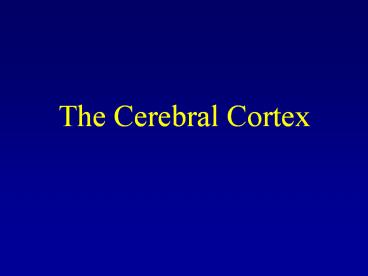The Cerebral Cortex - PowerPoint PPT Presentation
1 / 22
Title:
The Cerebral Cortex
Description:
The Evolving Brain ... The cross section of the human brain shows how the cerebral cortex has developed ... areas of the brain are responsible for integrating ... – PowerPoint PPT presentation
Number of Views:1208
Avg rating:3.0/5.0
Title: The Cerebral Cortex
1
The Cerebral Cortex
2
The Evolving Brain
- Different animal species have many structures in
common, including a cerebellum and cortex. - The cortex is much larger in mammals than in
species that evolved earlier, such as fish and
amphibians. - The cross section of the human brain shows how
the cerebral cortex has developed around and
above more primitive brain structures.
3
When it comes to CortexSize DOES Matter
- If flattened, a human cortex would cover about
four pages of this book. - A chimpanzee's would cover one page
- a monkey's a postcard
- a rat's a postage stamp.
- From Scientific American, October 1994, p. 102.
4
Areas of the Cortex
- More intelligent animals have increased
"uncommitted" or association areas of the cortex.
- These vast areas of the brain are responsible for
integrating and acting on information received
and processed by sensory areas.
5
Developing Brain
- Neural tubebeginning of nervous system develops
at 2 weeks after conception - Neurogenesisdevelopment of new neurons
Click above to view a video (529 long)
6
Forebrain Structures
Largest Brain Region with the most complex
structures. What separates us from the beasts.
7
Cortical Specialization
- Localizationnotion that different functions are
located in different areas of the brain - Lateralizationnotion that different functions
are processed primarily on one side of the brain
or the other
8
Brain has 2 Hemispheres
- Left Right sides are separate
- Corpus Callosum major pathway between
hemispheres - Some functions are lateralized
- language on left
- spacial relations, music on right
- Lateralization is never 100
9
Lateralization of the Hemispheres
An Example of Spacial Relations
Answer E
10
Each hemisphere is divided into 4 lobes
11
Lobes of the Cortex
- Frontal lobelargest lobe, produces voluntary
muscle movements, involved in thinking, planning,
emotional control - Temporal lobeprimary receiving area for auditory
information - Occipital lobeprimary receiving area for visual
information - Parietal lobeprocesses sensory information from
your body information
12
Frontal Lobe
- Contains primary motor cortex
- Important in judgment, planning and sequencing
areas - Controls emotional center of the brain (limbic
system) - Contains Brocas area for speech
- Prefrontal area for working memory (Short-Term
Memory) helps you remember what you just did so
you know what to do next (sequencing)
13
Temporal Lobe
- Contains primary auditory cortex interprets
hearing info - Inputs are auditory, visual patterns
- speech recognition
- face recognition
- word recognition
- memory formation
- Outputs to limbic System, Basal Ganglia, and
brainstem
14
Occipital Lobe
- Input from Optic nerve
- Contains primary visual cortex
- Makes sense of visual info
- Sends info to parietal and temporal lobes
Occipital Lobe
Visual Lobe
15
Parietal Lobe
- Receives info from multiple senses
- Contains primary somatosensory cortex
- your skin sense of touch and temperature.
- Sends info to Frontal lobe to help in
- hand-eye coordination
- eye movements
- attention
16
BOREDOM BUSTER!
- Lets Review with Pinky The Brain.
17
(No Transcript)
18
Motor Cortex Located at the back of the Frontal
Lobe. The more precise movements, the more motor
cortex the part uses up.
Sensory Cortex Located at the front of the
Parietal Lobe. The more sensitive the area, the
more sensory cortex it uses up.
19
Language and the Brain
- Aphasiapartial or complete inability to
articulate ideas or understand language because
of brain injury or damage - Brocas areaplays role in speech production
- Wernickes areaplays role in understanding and
meaningful speech
20
Aphasias
- Brocas Aphasia Damage to Brocas Area causes a
person to struggle formulating words while still
being able to comprehend speech. - Wernickes Aphasia Damage to Wernickes Area
would cause a person only to be able to speak in
meaningless words. - Example of Wernickes Aphasia Asked to describe
a picture of two boys stealing cookies from
behind a womans back, a patient responded, - Mother is away her working her work to get her
better, but when shes looking the two boys
looking the other part. Shes working another
time.
21
Language Areas of the Brain
22
How We Read Out Loud

